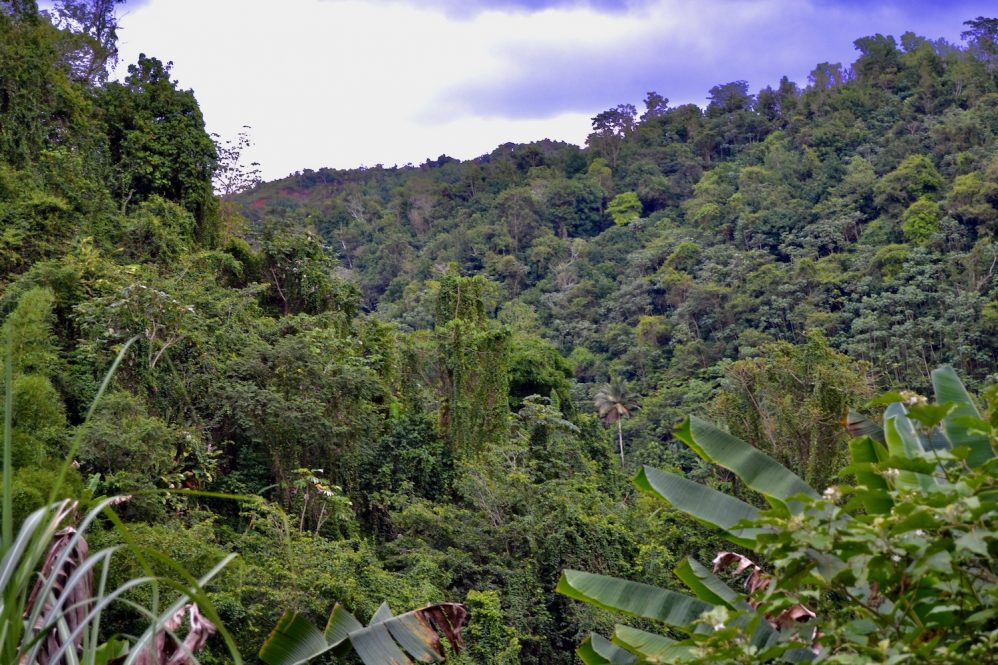As the world becomes more interconnected, some plants have benefitted from a greater ease in movement from one region to another, while some have become problematic. Some introduced species gain a competitive edge, spreading rapidly, outcompeting native vegetation, and transforming entire ecosystems. These species are known as "invasive," and they can disrupt food webs, alter […]

This view shows a mixed vegetation patch where native species coexist with aggressive invaders, says Rojas-Sandoval. This is an increasingly common scenario across tropical ecosystems. (Contributed photo)
As the world becomes more interconnected, some plants have benefitted from a greater ease in movement from one region to another, while some have become problematic. Some introduced species gain a competitive edge, spreading rapidly, outcompeting native vegetation, and transforming entire ecosystems. These species are known as "invasive," and they can disrupt food webs, alter ecosystem processes, and threaten biodiversity. To address this growing challenge, an interdisciplinary team of UConn researchers has developed an AI-driven framework to predict which plant species are most likely to become invasive before they even arrive in a new location.
Their work is published in the Journal of Applied Ecology.
Julissa Rojas-Sandoval as assistant professor in the Department of Geography, Sustainability, Urban, and Community Studies, and core faculty at the Institute of the Environment, teamed up with Department of Physics associate professor Daniel Anglés-Alcázar, and Department of Ecology and Evolutionary Biology professor Michael Willig to develop a project they each could not have done alone, says Rojas-Sandoval.
The idea began when Rojas-Sandoval became interested in exploring whether machine learning techniques used in astrophysics to classify galaxies could be adapted to ecology and applied to classify plants. Discussing this idea with Anglés-Alcázar and Willig, they determined that it was possible and started working together to test the concept, adapting algorithms from astrophysical applications," says Rojas-Sandoval.
"What is exciting is that we are not just providing a framework to classify plants as invasive and not, we are providing a way to identify which species have the potential to become invasive and problematic before they arrive in a new area."
Traditional invasion risk assessments have been effective at preventing widespread introduction of invasive species, says Rojas-Sandoval. However, these assessments can be subjective and time-intensive and often applied after a species has already been introduced. As a result, by the time a plant is formally recognized as invasive, it is already well established and difficult to control or remove. The new machine learning framework offers the possibility to evaluate for invasiveness before the plant takes root in a new area.
Rojas-Sandoval explains that this new methodology can help perform risk assessments before plants are cleared for import by identifying which species pose the highest risk of becoming invasive in the destination country. The researchers combined decades of ecological data with machine learning methods to create algorithms that can analyze patterns from previous species introductions paired with characteristics of the plant species that may enable them to become invasive in a new area.
The researchers used three sets of data for the analysis, including one set focusing on the ecology and biological characteristics of the plants such as reproduction strategies and growth form, a second data set related to invasion history, capturing whether and where the species had previously become invasive or caused ecological problems, and a third data set focused on traits related to habitat preferences for each species. These datasets were used to train the machine learning algorithms.
The researchers identified several impactful trends, including the previous history of invasion, says Rojas-Sandoval, where if a plant was problematic in several areas, it is highly likely to become problematic in new areas. Plasticity in reproduction was also a good predictor, meaning that if a plant can reproduce by seed, cuttings, or other means, this gave them an advantage. The number of generations in a single growing season was also important for enabling an introduced species to get a foothold and become invasive in a new environment.
This is a powerful new tool to complement traditional risk assessments, says Rojas-Sandoval. Traditional risk assessments rely on evaluations that typically consist of questionnaires by an experienced group of experts who gather information about a plant and make an assessment about whether it should be allowed to be imported or not.
"With these new machine learning tools our data-driven models can achieve over 90% accuracy in predicting invasion success," says Rojas-Sandoval. "This can help remove biases in the assessments and increase their predictive power."
The researchers were also committed to using widely available data to ensure that this methodology can be replicated in other regions. The focus for this paper was on Caribbean islands, and Rojas-Sandoval says the next step is to train the models with data for different regions. They are inviting other researchers to create similar data sets to evaluate if the model is robust enough to calculate the probability of invasion to other areas.
"We want to analyze other regions and see if the models can still successfully predict the probability of invasion, and if not, then we need to train new machine learning models specific for each area. In either case, machine learning requires high quality and diverse biological and ecological data, which is why extensive fieldwork is so important," says Rojas-Sandoval.
Though the current models may not be able to predict invasions at a global level due to the complexity and uniqueness of biological organisms, the researchers are confident that general patterns will emerge.
"We are not trying to replace traditional risk assessments, which have been vital for biosecurity until now," says Rojas-Sandoval. "This is a new strategy to take advantage of the wonderful datasets and machine learning tools available to complement previous methods and become more effective at preventing new invasions."






